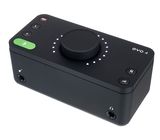I use Evo with a laptop.
Accordingly, the sound card itself and all related audio equipment are stationary, and the laptop follows me around the apartment and beyond.
In such conditions, I got the following experience in 4 months of use:
a) pluses
- on win 10, the card was installed as a native one and worked as accurately as a clock, right up to the notorious system updates;
- dimensions: small, very convenient, does not interfere on the table;
- preamplification: for a fairly quiet tube microphone (Nady 1100, not bad, but entry-level, and very old) it gives out smoothly. The impression that there is no color at all. At least on my cheap equipment (mostly in the non-professional segment), when the gain is changed, no metamorphosis in the signal is observed;
- Evo software mixer is simple and straightforward from the very beginning.
b) cons:
- case: since I use the device stationary, this does not concern me much, but if you often work in the field, you will want a more reliable case. Now, when you change the connected devices, you take the entire card in your hand and squeeze it with quite a little effort. But this effort is enough for fears that you will damage the device. I repeat: the card itself does not suffer in any way, but there is fear, and it distracts attention;
- weight: very light piece. If this is a plus during transportation, then be careful when working - position the cables so as not to catch on them and not accidentally throw the Evo off the table;
- compatibility: after recent updates to the win 10 system, reconnecting the Evo became problematic - the settings for bit depth, sampling frequency, and latency began to get lost. This can happen even during recording, resulting in signal interruption (the sound growls loudly, as if it lacks a buffer).
_____ I treat this defect as follows: before recording, I change all the audio settings in Evo and daw, save them, then return the old settings, save again. It's annoying, but it works. I don’t know what is the matter more - in the OS, Evo, DAW or all together, but this only applies to recording. More precisely, analog-to-digital conversion. I am inclined to conclude that the fault for this lies with microsoft, but nevertheless it is desirable that the audient react faster, and they do not seem to read letters.
It's all! When the problem of driver compatibility is fixed (no matter who it is - MS or Audient), this interface will give you confidence and peace of mind. You can get used to the control, and if you are lazy, use a software solution. And yes, if you only use it at home and do not disconnect from your computer, then the described problem will not occur.
And once again I want to draw your attention to the ergonomics of the device. You don't expect the virtues it has from such a small box. Great device.

